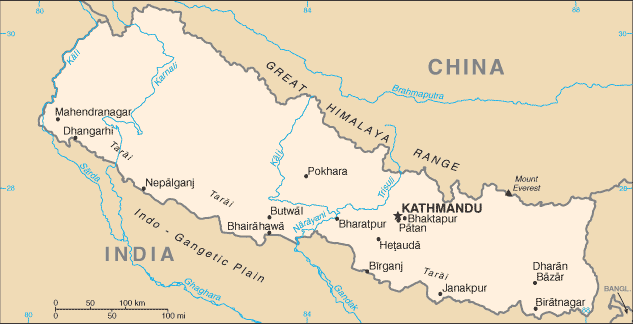Map:

Overview:
In 1951, the Nepalese monarch ended the century-old system of rule by hereditary premiers and instituted a cabinet system of government. Reforms in 1990 established a multiparty democracy within the framework of a constitutional monarchy. A Maoist insurgency, launched in 1996, has gained traction and is threatening to bring down the regime, especially after a negotiated cease-fire between the Maoists and government forces broke down in August 2003. In 2001, the crown prince massacred ten members of the royal family, including the king and queen, and then took his own life. In October 2002, the new king dismissed the prime minister and his cabinet for "incompetence" after they dissolved the parliament and were subsequently unable to hold elections because of the ongoing insurgency. While stopping short of reestablishing parliament, the king in June 2004 reinstated the most recently elected prime minister who formed a four-party coalition government, which the king subsequently tasked with paving the way for elections to be held in spring of 2005. Citing dissatisfaction with the government's lack of progress in addressing the Maoist insurgency, the King in February 2005 dissolved the government and assumed power in the Kingdom.
The People:
Population: 27,676,547 (July 2005 est.)
Age structure:
0-14 years: 39% (male 5,575,157/female 5,221,794)
15-64 years: 57.3% (male 8,137,410/female 7,720,691)
65 years and over: 3.7% (male 499,039/female 522,456) (2005 est.)
Religions:
Hindu 80.6%, Buddhist 10.7%, Muslim 4.2%, Kirant 3.6%, other 0.9% (2001 census)
note: only official Hindu state in the world
Government Type:
parliamentary democracy and constitutional monarchy
Leader(s) to pray for:
chief of state: King GYANENDRA Bir Bikram Shah (succeeded to the throne 4 June 2001 following the death of his nephew, King DIPENDRA Bir Bikram Shah)
head of government: Prime Minister Sher Bahadur DEUBA; note - the Prime Minister resigned in Februrary 2005
Source: The World Factbook
View All Countries